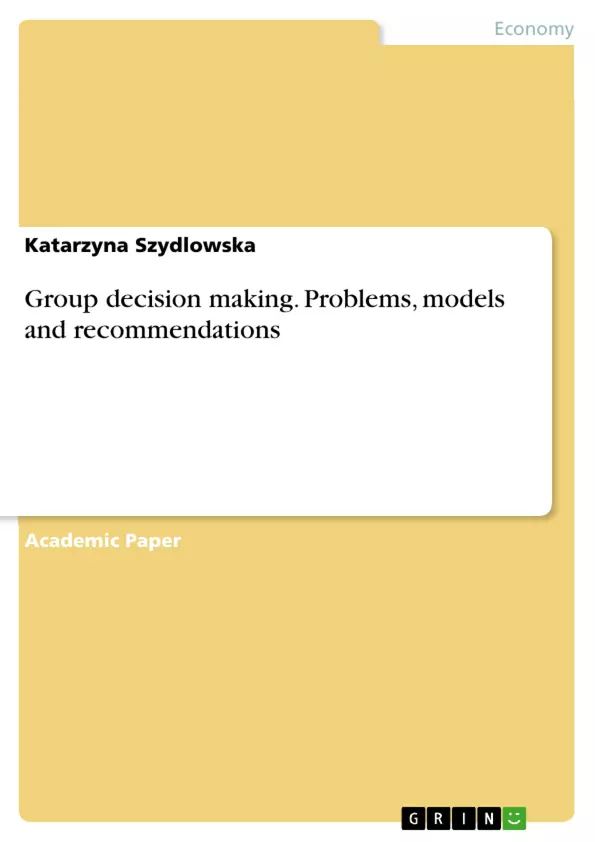This paper will highlight the main issues associated with the group decision making. Firstly, I will explain what is the group decision making in general and adduce the theories associated with this phenomenon. Furthermore, I will emphasize the problems of decision making such as group polarization, groupthink, brainstorming or the escalation of commitment. Moreover, I will stress the models such as democratic, laissez faire and autocratic. In addition, I will recommend some techniques in order to improve the group cooperation in making decisions. Finally, I will add the presentation as a summary of this report.
Table of Contents
- Executive Summary
- Introduction
- Problems with Group Decision Making
- Group Polarization
- Groupthink
- Brainstorming
- Escalation of Commitment
- Models of Group Decision Making
- Recommendations for Effective Group Decision Making
Objectives and Key Themes
This paper aims to explore the complexities of group decision-making, examining its inherent problems and proposing strategies for improvement. It seeks to provide a comprehensive overview of the theoretical frameworks and practical challenges involved in group decision-making processes.
- Problems inherent in group decision-making processes (e.g., group polarization, groupthink).
- Models of group decision-making (e.g., democratic, laissez-faire, autocratic).
- Strategies for enhancing group cooperation and decision-making effectiveness.
- The influence of individual personalities and group dynamics on decision outcomes.
- The role of information availability and external factors in shaping group decisions.
Chapter Summaries
Executive Summary: This section provides a concise overview of the paper's main points. It introduces the concept of group decision-making, outlines the problems associated with it (such as group polarization and groupthink), and briefly touches upon the models and recommendations for effective group decision-making. It acts as a roadmap for the entire paper, highlighting the key areas of exploration.
Introduction: This chapter defines group decision-making and emphasizes its significance in management. It introduces two key theoretical models: the descriptive model, which focuses on factors influencing decision-making (personality, group relationships, environment, information), and the behavioral model, which highlights the importance of individual behavior in group decision-making. The chapter also explores the concepts of certainty, risk, and uncertainty in decision-making contexts.
Problems with Group Decision-Making: This chapter delves into four common problems associated with group decision-making. It discusses group polarization (the tendency for groups to make riskier or more extreme decisions than individuals), groupthink (the suppression of dissenting opinions in favor of unanimity), brainstorming (a technique designed to improve group decision-making by generating numerous ideas), and the escalation of commitment (the persistence of commitment to failing courses of action). Each problem is explained and illustrated with relevant examples.
Keywords
Group decision-making, group polarization, groupthink, brainstorming, escalation of commitment, decision-making models, effective group cooperation, individual behavior, risk, uncertainty, management.
Frequently Asked Questions: A Comprehensive Language Preview
What is the purpose of this document?
This document provides a comprehensive preview of a paper exploring the complexities of group decision-making. It includes the table of contents, objectives and key themes, chapter summaries, and keywords. The purpose is to offer a structured overview of the paper's content for academic use and analysis of themes.
What topics are covered in the paper?
The paper covers various aspects of group decision-making, including: problems inherent in group decision-making processes (group polarization, groupthink, brainstorming, escalation of commitment); models of group decision-making (democratic, laissez-faire, autocratic); strategies for enhancing group cooperation and decision-making effectiveness; the influence of individual personalities and group dynamics; and the role of information availability and external factors.
What are the key problems discussed regarding group decision-making?
The paper focuses on four key problems: group polarization (groups making riskier or more extreme decisions than individuals); groupthink (suppression of dissenting opinions); brainstorming (a technique to generate ideas, but with potential drawbacks); and escalation of commitment (persistence in failing courses of action). Each problem is analyzed in detail.
What types of models of group decision-making are examined?
The paper examines both descriptive and behavioral models of group decision-making. The descriptive model focuses on factors influencing decision-making (personality, group relationships, environment, information), while the behavioral model emphasizes the importance of individual behavior within the group process. The paper also implicitly references various decision-making styles such as democratic, laissez-faire, and autocratic.
What recommendations are likely included in the paper (based on the preview)?
Based on the preview, the paper likely offers recommendations for improving group decision-making effectiveness. These recommendations are expected to address the problems discussed and provide strategies for enhancing group cooperation and achieving better decision outcomes.
What is the structure of the paper?
The paper follows a standard academic structure. It includes an executive summary providing a concise overview, an introduction defining group decision-making, a section dedicated to the problems of group decision-making, a section on models of group decision-making, and finally, a section with recommendations for effective group decision-making.
What are the key terms or keywords associated with this paper?
Key terms include: Group decision-making, group polarization, groupthink, brainstorming, escalation of commitment, decision-making models, effective group cooperation, individual behavior, risk, uncertainty, and management.
What is the intended audience for this preview?
The intended audience is primarily academic, focused on researchers and students interested in group dynamics, decision-making processes, and organizational behavior.
- Quote paper
- Katarzyna Szydlowska (Author), 2016, Group decision making. Problems, models and recommendations, Munich, GRIN Verlag, https://www.grin.com/document/512511



